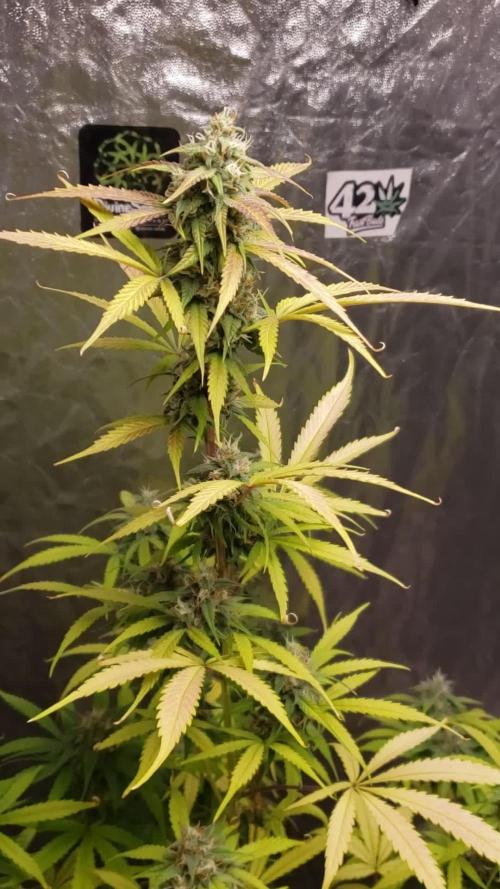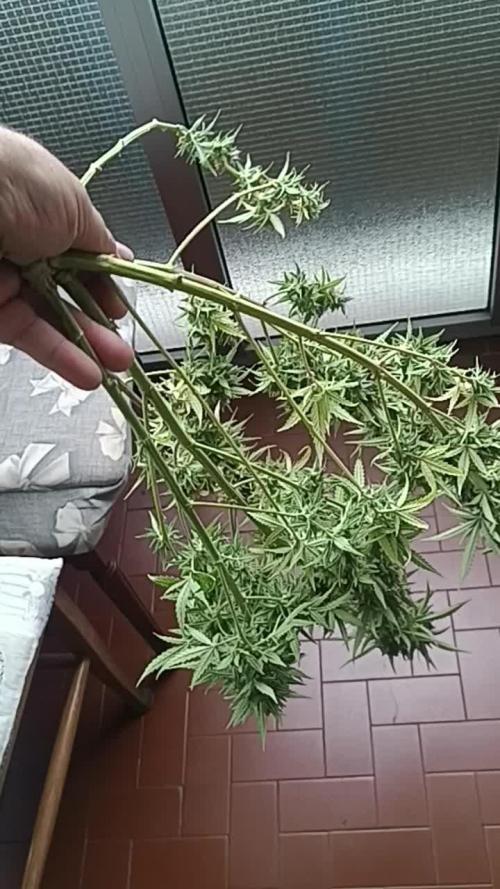The Grow Awards 2026 🏆 

































Likes
Comments
Share


@Spliffi
Follow
Week 13 20 December 2023
Once upon a time in a small town, a group of friends decided to embark on an unusual Christmas adventure. Instead of the traditional festivities, they hatched a plan to grow a special kind of Christmas tree—cannabis.
They called themselves the "Green Elves" and secretly transformed an abandoned greenhouse into their winter wonderland. As the weeks passed, they nurtured their unconventional crop with care, each day bringing new challenges and unexpected joys.
With Christmas approaching, the friends faced the dilemma of revealing their secret to the town or keeping it hidden. In the spirit of the season, they chose honesty, deciding to share their unique Christmas tale.
To their surprise, the townspeople responded with unexpected warmth and understanding. Rather than judgment, they found support and curiosity. The community embraced the unconventional holiday spirit, turning the greenhouse into a festive gathering place.
The Green Elves learned a valuable lesson about acceptance, and their cannabis Christmas tree became a symbol of breaking stereotypes and celebrating diversity. That year, the town had a Christmas unlike any other, filled with laughter, unity, and a touch of unexpected green magic.
Merry Christmas 🎅 🎄
Heya👍🤙👍🌱
Thanks for reading!!!🤙👍🤙🌱
Processing
Likes
65
Share


@Wicked_Stix
Follow
I did her first water change on day 10 upped the nutrient dose and increased the reservior to 12 gallons. Gave her the first dose of armor si and humic acid. I topped her on day 12 to start 4 main branches. Will most likely top again and start training in about a week depending on how she wants to grow. The goal is a maximum of 5 weeks veg if they cooperate. Of the 6 strains she is a little faster than the rest so far. They are under 240w qb and a galaxyhydro pulling about 140w for now. Will be adding more qb when I spread the buckets out.
Likes
16
Share


@Naujas
Follow
girl, from the beginning she was watered with water from the tap, the value of which is almost 350ppm. and a lot of lime, which prevents me from growing it bigger, but I'm happy with the result :) it's a small pot and only 50 w :) the flowers look very beautiful and sticky :) super
Likes
4
Share


@oregonian
Follow
Memory loss began to show female by july 4, so it's now 6 weeks since first hairs. I am using bamboo stakes (only on this girl) at about 3.5 feet above soil to create a canopy, similar to a SCROG. There are hundreds of budding sites. Star killer and Calif orange are just beginning to show female. Star killer 1 is being allowed to bud with minimal interference, star killer 2 has me reducing the number of buds to a dozen and cali will have only 2 colas. Daytime temps range between 80 and 100. But they are used to it and are thriving. nighttime 55-70. in containers. fed organic in flower twice. watering is whenever soil dries a bit and pulls away from edge. about 3 gallons does all 4 plants.
Plants are between 53 and 60 inches tall. Memory loss canopy is nearly 4 feet square. heavy watering 3.5 gal all 4 plants total.
Likes
31
Share


@bioaccessory
Follow
Hey!
At last the day of the harvest arrived. Before that, I stopped watering the plant 4 days ago, and turned off the lights 2 days ago. As for questionable techniques, I adhere to the principle - if it doesn’t get worse, why not try?😄
So, I put the harvested crop in a dark ventilated box, for about 10 days, I will observe.
p.s. I invite everyone to the next update of the diary - I will sum up, remember the interesting moments of the cycle, and of course I will try the finished product, see you! 😍
Glory to Ukraine! 🇺🇦
Likes
19
Share


@Hashy
Follow
********************************************
Week 13 Late flower (week 9 flower)
********************************************
Light cycle=12/12
Light Power=120w 50%
Extractor controller settings (during lights on).
High temp= 26c
Temp step=0c
High Rh= 46%
Rh step=0%
Speed max=10
Speed min=3
Extractor controller settings (during lights off).
High temp= 20c
Temp step=0c
High Rh= 50%
Rh step=0%
Speed max=10
Speed min=3
Smart controller settings (during lights on).
Lights on=9.00am
Smart controller settings (during lights off).
Lights off=9.00pm
VPD aim=1.0-1.5
DLI aim=40-45
EC aim=1.0-1.8
PH aim=6.0-6.5
💧💧💧💧💧💧💧💧💧💧💧💧💧💧💧💧
NPK= 5-14-20
Method= Automatic
Feed=Late Flower nutes
Neutralise=0.1ml/L
Plagron bloom=2.5ml/L
Plagron Power buds=1ml/L
Green Sensation=1ml/L
Easy Ph down=0ml/L
(1ml=24 drops, 1 drop=0.04ml)
Easy Ph Up=0.0ml/L
(1ml=24 drops, each drop is 0.04ml)
Ec=1.2 PH=6.3/6.0
Runs=10
Run times=3mins (0.75L/0.375L each)
Gap times= 17mins
Total runtime=30mins(6.0L/3.0L each)
Total flowrate= 0.25L/0.125L/min each
Auto start time=10.00am
Auto stop time=1.03pm
💧💧💧💧💧💧💧💧💧💧💧💧💧💧💧💧
********************************************
********************************************
📅3/5/25 Saturday(Day 85)
📋 Removed Radiator summer conditions from now on.
Small defoliation
💧
Automatic Water
Ec=0.2 PH=6.6/6.5
Volume=10L
Volume left=2.5L
Volume used=7.5L
Volume each=3.75L
Total runoff=0.6L
Ec=2.1 PH=6.4/6.4
💧
📅4/5/25 Sunday(Day 86)
📋
📅5/5/25 Monday(Day 87)
📋
📅6/5/25 Tuesday(Day 88)
📋
📅7/5/25 Wednesday(Day 89)
📋
💧
Automatic Late flower nutes
Ec=1.2 PH=6.2/6.0
Volume=5L
Volume left=1L
Volume used=4L
Manually
Volume =1L
Total used=5L
Total runoff=0.8L
Ec=2.5 PH=/6.6
💧
📅8/5/25 Thursday(Day 90)
📋
📅9/5/25 Friday(Day 91)
📋Day 63 of flower
********************************************
Weekly roundup.
📋My lung room is a little less crowded now I can take the radiator out of there. It's now the job of keeping the room cool as the season has changed. She's in late bloom now as pistils are starting to brown. The Fat bastard name really suits this plant, nice big flowers, I do have a bit of fox tailing going on the very top of the main cola but that can be expected for how close she is to the light. Still a way to go yet but she is doing great.
Back soon.
Take it easy.
********************************************
Likes
3
Share


@The_Doctor_Green
Follow
Hola a todo el mundo!!!.
Esta semana solo regué con agua, ya que he visto las hojas no muy bien. Y mañana ya comienzo con el lavado de raíces.
Espero ansioso el corte🤪🤪🤪😅😅😅
Hoy 22/10/25 es el dia 70, mañana comenzare el lavado de raiz.
El video corresponde al día 70
Likes
1
Share


@GnomeMoe
Follow
🗓️
Week 8 Flower, week 14 total
🍊 🍪🌲
Mandarin Cookies #2 (back right) is finishing up. MC #1 (back left) & MC #3 (Center) still have probably another solid week to fatten up. All MC’s are on a diet of water only, PH 6.2
🥈🥦
Silver Kush #1 (front left) has a solid week left. SK #2 (front right) is pretty far behind. I’ll probably just cut #2 down and dry it where it’s at, when I cut SK #1.
I can’t postpone my next grow just to let the small one get a few more grams. More than likely it’ll all go in the bubble bags.
I hope to have them all cut and drying by next week. ✂️ 🌲
💧 🗓️
Feeding schedule for S.K. since MCs are water only:
1 gallon water/nutes per 2 plants every other day
PH 6.2
MC’s are on water only Flush. PH 6.2
⛏️
Soil:
(1.5 C.F.) Fox Farm Ocean Forest, mixed with (1.5 C.F.) garden soil, fills (5) 5 galllon fabric pots perfectly. (50/50 mix.)
💡
Again, The new version of Spider Farmer SF-4000 is an awesome light, for anyone wondering.
Can’t say enough good things about this light!
This is my first LED and it seems to be doing fantastic.
(The pictures:
I re added the overall and video from last week, day 6. It was the final minutes before the light shut off. So pretty close to day 1, week 8...)
Likes
19
Share


@cam0538154
Follow
Slight trimming then hanging to dry. Will weigh up and comment once died and edit this diary once I have the numbers.
Likes
20
Share


@Vegetoo420
Follow
Girl Scout cookies started to get colors and she’s frosty ! Pleasure for the eyes and for the nose ! Definitely love this strain !
Likes
5
Share


@JeyGanesha
Follow
Queste grape ape sono cresciute benissimo la qualità è più che buona..per la mia patologia funziona benissimo. Molto efficace...sé ritrovo i semi la rifarò
Likes
5
Share


@negyhusztv
Follow
2 nd time of flushing, also we fimming them and prepare the box and setup for vegetation stage they are just tarting to streching slowly looks nice all off them but one of them is 3 x timex bigger then others...
Likes
5
Share


@FourVentiFarms
Follow
10th week of flowering: week from 23/10 to 29/10
This is the last week of flowering for this strain.
Unfortunately here in north eastern Italy the outdoor climate isn’t so kind in this period. So even If I wanted to let them mature a bit more, the temperature at night goes to 10°C.
It hasn’t perfectly matured, but that’s what I have.
I noticed some trichomes have lost the head or sphere at the top. I read that’s due to low temperature, so I see myself forced to harvest it now. Also it’s better to get them out the rain since bud rot and mold are still spreading in some branches.
Likes
10
Share


@MoMedicalAlchemist
Follow
Week 1 of flower everything looks great and green fed full strength Emerald Harvest full strength. A little bit of there terms are coming out now and they smell good already
Likes
6
Share


@Lordviper28
Follow
All the girls looking good all have bud forming on their tops this strain has been really with no problems at all. All except one has staid short and bushy the one topped stretched up and fanned out real nice
Likes
47
Share


@blazin_skywalker
Follow
Day 44 - Today it's time to say sayonara to the undergrowth as I clear away a lot of the fan leaves and make room to further shape the canopy.
I took each of the 8 branches that I previously cuffed off to fan leaves, and tied them down into their final resting place - rounding out the final shape of the plant.
Day 47 - Defoliation ✂️ - over the course of 3 days, this lady bushed out like woah - causing me to dive back in the the scissors.
Ermahgerd! 😱 She showed me a ♥️!
Likes
15
Share


@MrGrowMan
Follow
Week 8-9
1 nutrient water
1 non nutrient water
LsT and Scrog
Diesel and Mimosa (front 2) start flowering
2 break up cake (end 2) pH problems (6.8 pH runoff :/)
Scrog start
all pH problems, runoff 7.0 pH


























